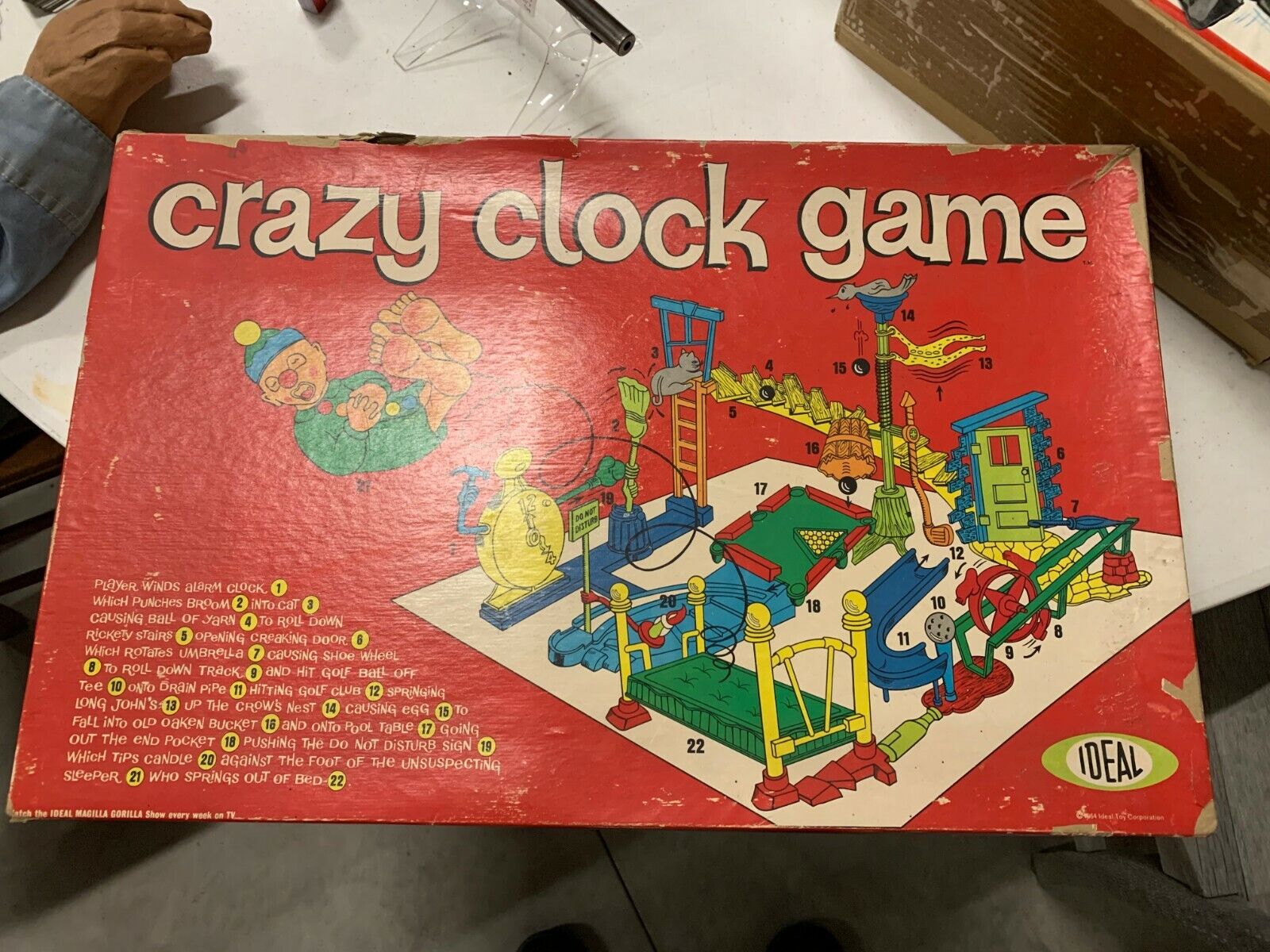Crazy Clock Game (1964)
Crazy Clock Game
The Crazy Clock Game is a board game released in 1964 by Ideal, taking players on a Rube Goldberg-inspired journey to spring a man from the comfort of his bed. The game was designed by Hank Kramer of Ideal Toy Company and was influenced by the works of Rube Goldberg. The original “Mouse Trap” game, released in 1963, was also designed by Kramer and was heavily influenced by Goldberg’s illustrations. Although Goldberg never saw a dime from “Mouse Trap,” the game became a massive success, selling 1.2 million copies in 1963 alone.
Game Components of Crazy Clock Game
The game comes with a pack of cards illustrating, step-by-step, how to build the Rube Goldberg contraption. The deck is dealt out randomly to the players.
Game Setup of Crazy Clock Game
Players take turns rolling a die to advance their mouse piece along a path around the game board, from the start space to a continuous loop at the end. The game proceeds as follows:1. The player with card 1 plays it, assembling the parts indicated on the card.2. The player continues playing cards in sequence if they can.3. When a player can no longer play cards, they grab a new card and continue playing.4. After fully assembling the machine, players take turns trying to operate the machine, starting with the player who installed the last component.
Gameplay Mechanics of Crazy Clock Game
The game is a race to build a Rube Goldberg machine, and the deck of cards is dealt out to the players. Players take turns playing cards to assemble the machine, and the game ends when one player successfully operates the machine.
Game Objective of Crazy Clock Game
The objective of the game is to be the first player to successfully operate the Rube Goldberg machine.
Player Experience
The Crazy Clock Game offers a fun and engaging experience for players, as they race to build a complex Rube Goldberg machine and operate it successfully. The game is suitable for young children and families, providing an entertaining and educational experience.
Related Games
“Mouse Trap” is a popular board game that shares similar Gameplay Mechanics of Crazy Clock Game and is also influenced by Rube Goldberg’s work. Other related games include “Fish Bait” and “Crazy Clock,” both designed by Marvin Glass and Associates in the 1960s.
Conclusion
The Crazy Clock Game is a fun and engaging board game that offers players a unique and entertaining experience. Inspired by Rube Goldberg’s work, the game challenges players to build a complex machine and operate it successfully. With its simple Gameplay Mechanics of Crazy Clock Game and appealing theme, the Crazy Clock Game is suitable for young children and families alike.
Game Components of Crazy Clock Game
How To Setup Crazy Clock Game
Setting up the Crazy Clock Game involves carefully assembling the various components in a specific sequence. The game comes with an instruction sheet that guides players through the setup process. Here’s a simplified overview:
Gameplay Mechanics and Game Objective
Player Experience
The Crazy Clock Game offers a unique and entertaining experience, especially for children and adults who enjoy mechanical puzzles. The setup process can be quite engaging, as each component must be carefully placed to ensure the chain reaction works. The game requires patience and attention to detail but rewards players with a satisfying and often humorous conclusion.
Pros
Cons
Personal Thoughts on Crazy Clock Game
The Crazy Clock Game is ideal for families, especially those with children who enjoy hands-on, mechanical puzzles. It’s a great way to spend quality time together, teaching patience and problem-solving skills. For collectors of vintage toys, this game is a gem that offers a nostalgic trip back to the 1960s. However, it may not be the best fit for very young children due to the complexity and fragility of some components.
We are supported by our audience. When you purchase through links on our site, we may earn an affiliate commission, at no extra cost for you. Learn more.

